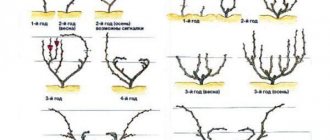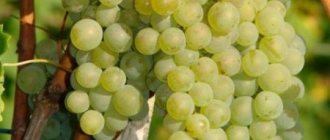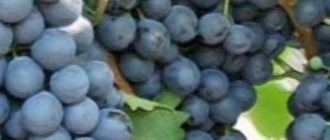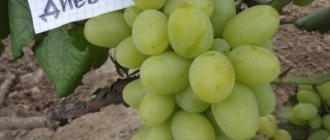Fruits and berries » Grapes
0
1100
Article rating
Kira Stoletova
There are 2 versions of the origin of the Marshall Forsch grape. Some say that he is Riparia crossed with the variety Rupestris 101-14 and Goldrisling. Others write that it was derived from Oberlin 595 and the Goldriesling variety. The Marshall Foch grapes are early ripening, characterized by active growth and excellent ripening of shoots.
Features of Marshall Foch grapes
Features of Marshall Foch grapes
There are 2 versions of the origin of the Marshall Forsch grape. Some say that he is Riparia crossed with the variety Rupestris 101-14 and Goldrisling. Others write that it was derived from Oberlin 595 and the Goldriesling variety. The Marshall Foch grapes are early ripening, characterized by active growth and excellent ripening of shoots.
Features of Marshall Foch grapes
Reviews from winegrowers about Marshal Foch grapes.
« We have great growth power in the grafted crop, even the harvest is not a hindrance to it.” (Svetlana Krasokhina, Novocherkassk, Rostov region, Russia)
"Threw it away. There are a sea of vines, the harvest is meager. I didn’t get to winemaking. I'm not such a workaholic as to collect this nonsense. + you also need to cover. I tried a lot of wine from this variety, but I didn’t like it. I’m probably biased somehow, but...” (Girts, Bauska, Latvia)
“My MF is in its fifth year, growing in partial shade (sun after 11 o’clock) occupying a little more than a meter of trellis. In the description of the variety it is often written that it is less productive than its twin brother Leon Milhaud. I grow both of them in approximately the same conditions; naturally, they are compared every year. In previous years there was approximately equality in both the amount of harvest and the amount of sugar. And this year, MF took a sharp lead, overtaking LM by more than twice the yield (3.8 kg versus 1.4 kg). The sugar levels in the wort are 19 and 21, respectively (the difference in load affected this). The vines ripened approximately equally (by four). Disease resistance is also a four. » (Sergey Timakov, Domodedovo, Moscow region, Russia)
Characteristic
France is the birthplace of this culture. It is used in the production of red and rose wine.
The vegetative period of the plant is up to 125 days. The grapes begin to ripen in late August-September, depending on sunshine.
The variety is resistant to cold and frost, surviving cold from -32°C to -40°C without shelter.
Marshall Foch does not like high temperatures and prefers sandy soil. It tolerates drought well.
Description of the bush
Young stems take root well during spring planting, and the vine is characterized by active growth.
The bushes have a large number of clusters, the weight of which on average reaches 100-200 g. Be sure to carry out pruning, as the branches grow quickly.
Description of berries
According to the description, the berries are deep blue, smooth, elastic, with a tough skin and small, which attracts the attention of birds.
They ripen in leaps and bounds. The degree of ripeness of the bunches levels off over the course of a week. Sometimes the harvest has to be partially harvested, which is inconvenient for those with small vineyards.
Growing
Marshall Foch grapes grow on sandy soils, but sandy loam, clayey and loamy soils are also suitable.
Before planting, prepare the soil: free it from excess vegetation (weeds), saturate it with useful elements such as black soil or humus-rich garden soil.
The application of fertilizers is beneficial for grapes: both organic and mineral. On soils poor in minerals and nutrients, it is advisable to add compost obtained from kitchen, garden and garden waste.
It is better to buy the plant in containers: this way the root remains intact, and it is already saturated with fertilizers. In this case, the seedling is guaranteed to take root successfully.
Needs watering during fruiting period
The plant must be fed with organic matter. Covering in winter is not necessary.
For the first time, Marshall Foch grapes are pruned in the fall, when they reach the age of 3 years. This allows you to achieve better fruitfulness of the plant. The load on the bush should be 55-65 eyes.
In spring, shoots are broken off.
The plant only needs watering during drought. This is especially true during the fruiting period.
Diseases and pests
Protection from pests and diseases is one of the most important aspects of growing berry bushes. For this purpose, chemical preparations are suitable, the treatment of which is carried out during the development stage of the plant.
- Oidium. This disease manifests itself at the stage of bud break and leaf appearance. The drugs “Shavit”, “Falcon”, “Novopidon”, “Tolendo”, “Topaz” help fight the disease.
- Black spot, gray mold, mildew, grape budworm. These diseases appear before flowering. To combat them, the means “Quadris” and “Match” are used. They guarantee the integrity of the flowers for a month. At the end of flowering, Tiovit Jet, Akarin, Neoron and Ridomil Gold are used to combat mildew, oidium and mites.
- Soil pests - cockchafer and cutworm. Against them, the crown of the plant is treated with the drug “Antikhrushch”, “Aktara” or any other based on imidacloprid. After 1.5 months, spraying is repeated.
Marshal Foch grapes - description of the variety, photos, reviews, videos.
Origin of the Marshall Foch grape
Technical hybrid grape variety of French origin. It was developed in France in the 1920s by Eugene Kuhlmann, who crossed the Goldriesling grape variety with the American grape variety Vitis riparia-rupestris and obtained a hybrid form, numbered Kuhlmann 188-2. The variety came to the United States in 1946, where it was subsequently renamed in honor of the French Marshal Ferdinand Foch, a World War I general. It is believed that this is due to the heavy losses suffered by the marshal's troops in battle, since wines from the Marshal Foch grape are especially distinguished by their deep blood-red color.
The variety was widespread in the first half of the 20th century, when burying the vine in snow to protect against winter frosts in continental regions was common practice.
Because the Marshall Foch grape is a hybrid variety, it is no longer found in commercial quantities in its native France, although it once covered large areas throughout the Loire.
Name in the language of the country of origin: Marechal Foch
International name: Marechal Foch
Synonyms: Marechal Foch, Kuhlmann 188-2, Kuhlmann 188-2
Video reviews about Marshal Foch grapes.
Review of wine from Marshal Foch grapes, Garage Winery channel, Belarus.
Review of Marshall Foch grapes. Canal Sadova Dolina, village. Velikiy Dalnik, Odessa region, Ukraine. Review and measurement of sugar accumulation in Marshall Foch grapes. Sokolman Sergey, Poltava region, Ukraine. A story about the Marshall Foch grape variety and its formation on pine. Channel Alexander Mikolenko, Belarus. If you grow Marshall Foch grapes, send us your review or photo of it, we will post your review or photo in this article.
Good luck with your grape planting and good harvests!
Read even more articles on Yandex.Zen
Marshall Foch - technical, wine grapes
- Send topic by email
- print version
Re: Marshall Foch
Post by EvgeniyTula » 10 Sep 2010, 08:25
Re: Marshall Foch
Post by Belarus Grodno » April 11, 2015, 6:15 pm
Re: Marshall Foch
Post by EvgenyTula » April 11, 2015, 11:03 pm
Re: Marshall Foch
Post by Andrey Nikolaev » 22 Sep 2015, 14:28
Dear, please tell me what “ambushes” there are during the maceration of Marshal Foch on pulp? There is very little information about this variety in winemaking. One person online wrote that “if this grape variety is left to sit on the skins, it develops a musky, metallic aroma. Some people like it, but I think these aromas are too coarse for a wine like this and lack subtlety. Foch can be processed in the same way as Chardonnay - colored and infused on the skins and pits overnight, then squeezed out and left to ferment - to create a strawberry-hued nouveau that can be drunk after a few months - it's actually delicious."
Another - who macerated on MF pulp for the first time for 2 weeks - “it turned out brrrr. “(I don’t know what exactly was meant), the second time I macerated for 1 week - “it’s already better, but I think 3 days would be enough.” What do you think is “musk”, “metal” and “brrr” in the taste and aroma? What does your experience say about what should be the maximum period of maceration of MF at 20-25 degrees in order to obtain a sufficiently extractive, dark, and not strawberry-colored dry wine (quite strong in alcohol)?
And another question. I haven't tried eating MF myself yet. Is it normal to just eat it? :) Or is he only “skin and bones” for wine? :) They also say that even its skin is tough to chew. Is this true, is it delicious? : ) Thank you : ))
Forum statistics
207036 Messages in 1634 Topics from 5593 Users. Last user: Amaya Last message: “Let's talk about the weather in Vash...” ( Today at 07:52:22 ) Latest messages on the forum.
Now on the forum
33 Guests, 11 Users
Users in the last 15 minutes: Nikolay S., therapist, 64nikolay64, Marshal, Svetla777, Liza, lomakin1969, Alexander Vl., Elvira2017, Andrey76, Slavka [Blocked] [Section Moderator] [Forum Moderator]
Maximum online today: 77 . All-time maximum online: 2758 (28 July 2021, 17:22:51)
Users who visited the forum in the last 24 hours
Total: 295
(Visible: 294, Hidden: 1) 1963, Nikolay S., therapist, 64nikolay64, Marshal, Svetla777, Liza, Capricorn, lomakin1969, Alexander Vl., Elvira2017, Andrey76, Slavka, Mikhail77, ElenkaF, Tatyana B, Alex65, Cherkessk, Eugene, zsb, leonidych, vladimirM, yotmast, mers, Serg1707, SNovichek, hanter64, znakomij, Alexander K, Vardan, Sergey Fer, Anatoly Sivkov, Alexey V, Ilya 77, Andrey gladilin, Tatyana A., Belgorodets, in Astrakhan, Oksana Kopp, sem_en, Vladimir 153, skier, Igor Viktorovich, slavalimon, Primorets, OlgaOs, SANYCH, 31rus, mystic69, DorontsovPeter, Andrey Tsvetkov, Buba, igor222, Elena Z, vlad51, Kenig, Nikolay Rex, Sergey 1965, Vladimir Buturlakin, DSW , psv1960, Dmitry 77, Vasily V., Vyacheslav03, Natalia Nikolaevna, Sergey Tashchiyan, Igor Sergeevich, alexsandr, kvg, Pioneer, Ekaterina Polyanina, nicson7, Elena Aleshchenko, Alexander-ask-34, Verona, Igor F., Taker, Quiet , Henry, Yuri72, L.A.P., Gaivoronsky Yuri, Sergeevich, Sergei Chistokletov, Svetlana Streletskaya, Galinka, Alexey Deminov, Naumov Igor, Vyacheslav136, Gloomy, Katrin, AndSanych, Mikhno Alexander, Ded31, Filippov Oleg, Vladimir ++ , Mikhail Alekseevich, Lydia58, ALEXANDER BRYANSKY, Vladimir-kanevskaya, DIL, Amber7394, Marina Protasova, TITOVA LYUBOV, Linx, alexander66, Natalya M, Mikhail Fesenko, Amaya, Alexander71, Boris 1952, tsv, Maximilian, 25nata35, nadia, GALINA A NOKHINA , Igor_K, Alexander Kolesnikov, Ivan Levin, Pitko, weather forecaster, eSAa, cecet71, atseton, Alexander Smirnov, Vladimir Kostochkin, Vladimir Berdnikov, Gocha, pioneer-2, LeXa_KoT, Sergey 61, Sergey Yuryev, Erem, alexss, Evgeniy52, Skif, Vladimir Kovba, dayton, Yuri Semyonov, N.A. Sokolov, Pavlentiy, Sa-shura, Volgogradka, Dmitry Anatolyevich, Grandfather Igor, Andrey Lis, Bublichenko Alexander M, Marina Krymskaya, stenlly2010, irahelm, Vyacheslav Vladimirovich, Vladimir Shilov, Aprel, Badaev Dmitry, gheo55, Yura, y_fed, rambo, Yagodka, Valentina Ivanovna, Kryn, oleg9f, DED2, Svetlana Korotina, Zavezen Oleg Ivanovich, Eduard., santra, L2k2m7n, Alexander48, Viknik, Andrey 31, m2d, Valery Rastorguev, Soshnin Yura , Amateur gardener, Galina, Vasily1111, gardener, marlin64, Salex, sergei, Sergey Ko, Ramiz, viktor_, kosmos, potap05, Yuri 36, VitalySD, Inna161, Vova Kapran, Vladimir Shcherbinin, Valerie, niy1, cfibr, Andrey68, kulol3 , thanatos, Serzh1978, Realist, Artur53, max2008-01, LOZA, AlexanderD, Grandfather Young, Natasha, Zayac, ketch, Rita, alx-74, Iv Iv, Alexander150, Igor K, Vasily Viktorovich, VeraNiK, kdm57, Veniaminovich, Boris Sokolyansky, 77volt, , vikbublik, neposny, Evgen, Victoria Aleksandrovna, Serezha 64, Wintel, Airbone, teri, Sergey Lomonosov, Khramov, serginio, Leonty Yarygin, Irina O., Ser, Nadezhda Grig, Lyubov S., netolya, Saisan, Agryzkov Alexey, Vadi, Zinaida, Vadim, Alexander Taganrog, Sukhonos Sergey, Snezhinets, evgen_26, nau_63, Masha_gardener, Gennady163, krasnovlad1, Alexander Zinoviev, Vasily 53, Roman Fedorovich, TIS, Alexey Sergeevich, arnyusha, Zheka, Nurtas, kradievska, nick041 , Valentina Medvedeva, Sergey43, Andrey S., Nikolay Lipunov, Mst, Vertuoz2, Vladimir VS, NatalyaMed, freesia, Kinna, Mikhail Michurinsk, alekcsan1, VALERY TAMB, Sasha57, MikhAf, Y_Azer, Andrey Beribesov, hunter1955, nut lover, Keys, Ivan Shmelev, Pestik, anton_slash, Nadymchanka, Sergey 31, Volgar, Pavel 64, Tatyana Volzh, Elektronik_t, Alexander 61, spotlight, Alexander Guy, Cheprak, Pirko Alexander, vladimirvrn
Description and emergence of culture
Information about the origin of this species varies: in one source you can find information that Marshall Foch was obtained as a result of crossing Riparia, Rupestris 101-14 and Goldrisling, in another - a description that it was obtained by crossing Oberlin 595 and Goldrisling.
The variety is an early ripening variety; the vegetative period lasts no more than 125 days. It begins to ripen, depending on the sunshine of the region, at the end of August and September. With average growth vigor, the bushes have high growth vigor and demonstrate shoot ripening at a high level. Marshal Foch's homeland is France; breeders initially planned it as a technical wine variety, with high fruitfulness and load.
Features of culture:
- Moderate resistance to low winter temperatures. The Marshall Foch grape variety, according to various experts, is able to withstand winter frosts from minus 32 and below minus 40 degrees. There are also specimens that have successfully overwintered at minus 43, without shelter or wrapping. But the plant does not like high temperatures, preferring sandy soils, while being resistant to drought. When planted in spring, young cuttings take root well, even in late spring frosts, and are characterized by rapid seasonal growth of the vine.
- Increased resistance to fungal plant diseases, mildew, rot and oidium, especially resistant after sanitation against fungus. It is necessary to carry out 1-2 treatments per year. As a preventive measure against fungal diseases, pruning can be done - in the summer the bush grows back almost at lightning speed.
- The fruiting coefficient is 1.3. There are many clusters on the bush, each weighing up to 200 grams. The berries are blue, perfectly smooth, round and small, covered with a white coating, and when held up to light they are pink. They have a strong skin and elasticity. During the summer they ripen unevenly - one bunch may already be completely ready for wine production, while the neighboring one may remain green. As a rule, within a week the fruits are compared and become ideal in taste. But in some cases you have to harvest the harvest in parts, which is not very convenient, especially for the owner of a small vineyard. To increase the fruiting of the bush, you can arrange autumn pruning; this procedure is especially relevant for barren and dry shoots.
Light red and rose table wines are produced from the Marshall Foch variety, which is a technical variety. The drinks have a noble shade of Burgundy wine. There is an opinion that this variety is used by real masters only as a “paint” when sepaging with other varieties, since this grape is only capable of producing a noble color. However, real experts know the secrets of how to prepare a high-quality product from one Marshall.
Grapes Marshall Foch
Description and emergence of culture
Information about the origin of this species varies: in one source you can find information that Marshall Foch was obtained as a result of crossing Riparia, Rupestris 101-14 and Goldrisling, in another - a description that it was obtained by crossing Oberlin 595 and Goldrisling.
The variety is an early ripening variety; the vegetative period lasts no more than 125 days. It begins to ripen, depending on the sunshine of the region, at the end of August and September. With average growth vigor, the bushes have high growth vigor and demonstrate shoot ripening at a high level. Marshal Foch's homeland is France; breeders initially planned it as a technical wine variety, with high fruitfulness and load.
Features of culture:
- Moderate resistance to low winter temperatures. The Marshall Foch grape variety, according to various experts, is able to withstand winter frosts from minus 32 and below minus 40 degrees. There are also specimens that have successfully overwintered at minus 43, without shelter or wrapping. But the plant does not like high temperatures, preferring sandy soils, while being resistant to drought. When planted in spring, young cuttings take root well, even in late spring frosts, and are characterized by rapid seasonal growth of the vine.
- Increased resistance to fungal plant diseases, mildew, rot and oidium, especially resistant after sanitation against fungus. It is necessary to carry out 1-2 treatments per year. As a preventive measure against fungal diseases, pruning can be done - in the summer the bush grows back almost at lightning speed.
- The fruiting coefficient is 1.3. There are many clusters on the bush, each weighing up to 200 grams. The berries are blue, perfectly smooth, round and small, covered with a white coating, and when held up to light they are pink. They have a strong skin and elasticity. During the summer they ripen unevenly - one bunch may already be completely ready for wine production, while the neighboring one may remain green. As a rule, within a week the fruits are compared and become ideal in taste. But in some cases you have to harvest the harvest in parts, which is not very convenient, especially for the owner of a small vineyard. To increase the fruiting of the bush, you can arrange autumn pruning; this procedure is especially relevant for barren and dry shoots.
Light red and rose table wines are produced from the Marshall Foch variety, which is a technical variety. The drinks have a noble shade of Burgundy wine. There is an opinion that this variety is used by real masters only as a “paint” when sepaging with other varieties, since this grape is only capable of producing a noble color. However, real experts know the secrets of how to prepare a high-quality product from one Marshall.
The wine produced from this type of berry contains a fairly high percentage of alcohol and produces high sugar - up to 25%. These reviews mainly belong to southerners, however, the wine turns out to be light, unobtrusive, and the cultivation of such grapes will be especially interesting to northerners.
Those with loamy and other heavy soils on the site will not be able to grow Foch, as it prefers light sandy soils. But the owners of a plot “on the sand” have every chance to grow a fruit-bearing bush from a two-year-old seedling in one summer and get an excellent dessert wine from it. It is worth remembering that the small berries of Foch are very attractive to birds and you will have to install a thrush repellent system on your site in order to save the grapes.
The beauty of this type is that the taste of the resulting wine is average - it produces a good dry wine that will not disappoint the majority of those who try this drink, and with an average bouquet and aroma, it will be remembered for a persistent harmonious aftertaste.











